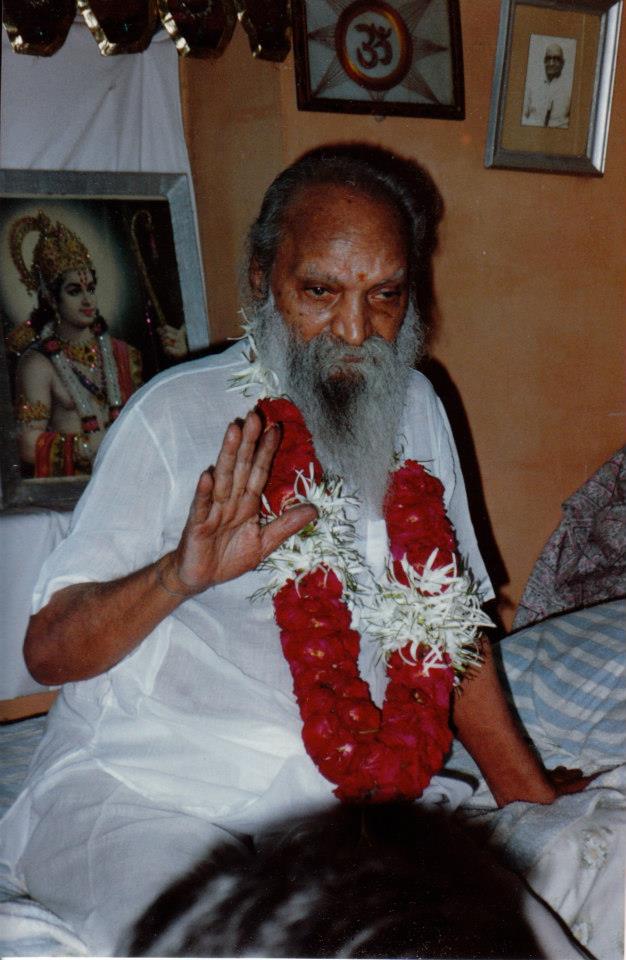Teaching
Indian Spirituality Principles*
“On a long journey of human life,
faith is the best of companions;
it is the best refreshment on the journey;
and it is the greatest property.”
~ Buddha
“Faith is the highest passion in a human being.
Many in every generation may not come that far,
but none comes further.”
~ Soren Kierkegaard
“I tell you the truth,
if you have faith as small as a mustard seed,
you can say to this mountain,
“Move from here to there” and it will move.”
~ Matthew 17:20
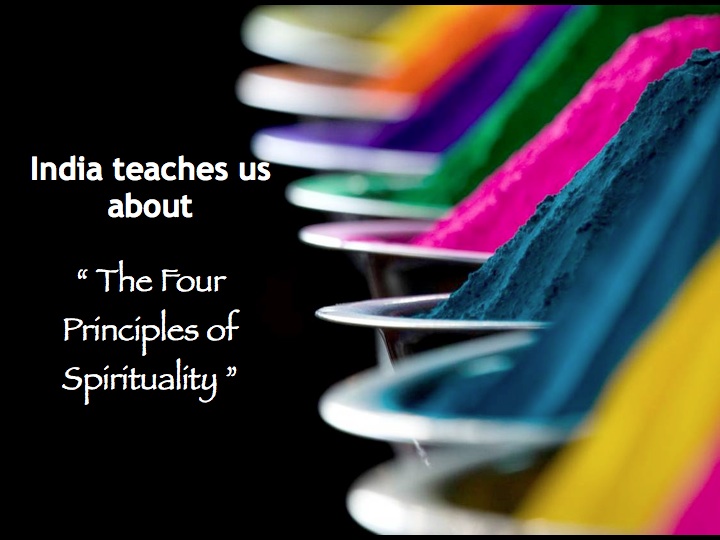
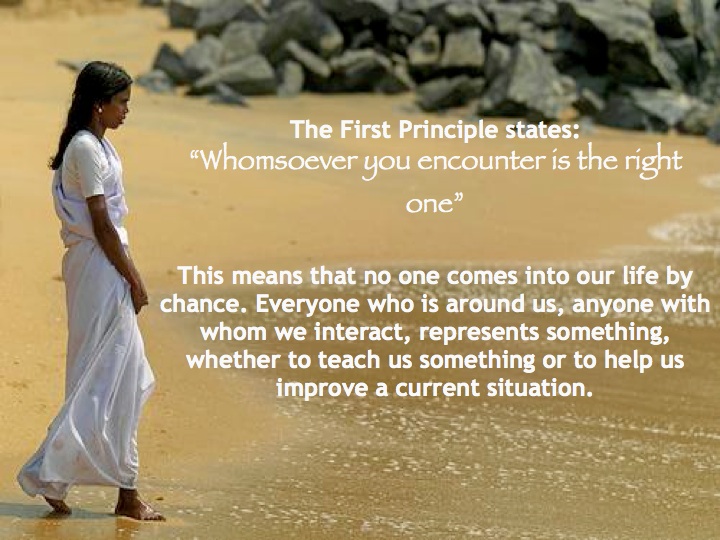
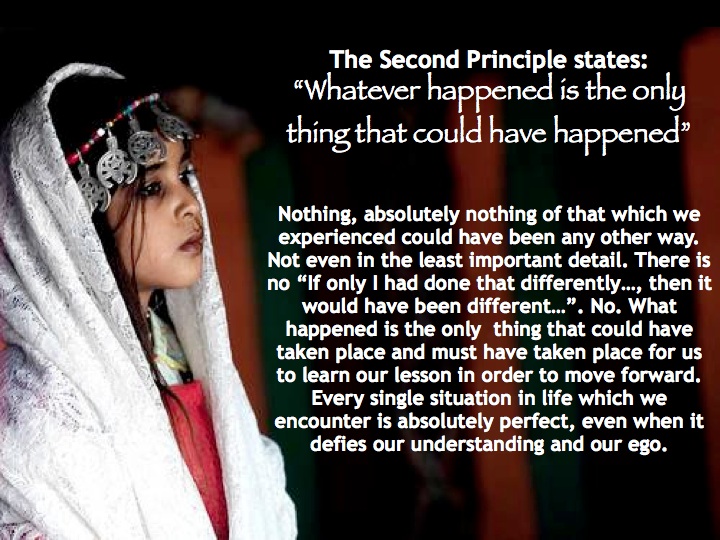
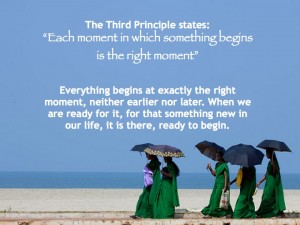
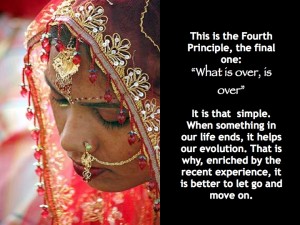
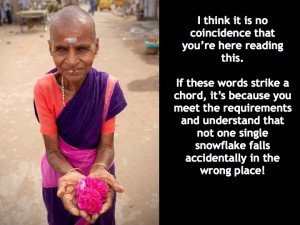
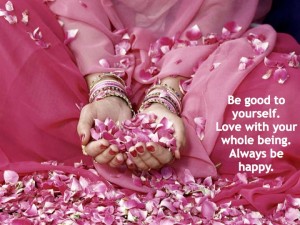
Ron’s hints for happiness:
Even if it’s difficult for you to believe these spiritual principles, your life will be happier if you live as if they were true, with faith and love. Whether or not you believe in spiritual evolution or predestiny, just pretend that everything in your life is happening for the best, in the best way and at the best time. And accept difficulties as evolutionary opportunities, without remorse or regret about the past or worry or fear of the future. Sow love, harvest happiness.
Downloadable pdf file: IndianSpirituality
* Source and author are unknown
Ron’s Optimism Commentary:
Dear Friends,
Today I share the above simply written but possibly profound article – by an anonymous author – titled “Indian Spirituality Principles”, preceded by quotes about faith. Please reflect on their message.
The article says that there are no coincidences or accidents in our lives; that everyone we encounter and everything that happens or doesn’t happen to us, can help us learn to live happier lives.
From long life experience, I have gratefully and joyfully discovered that our earth life in precious human bodies is a rare and immense evolutionary opportunity for us to advance – individually and societally – toward realization of unlimited human and spiritual potentialities.
With boundless and abiding faith that our lives are completely enveloped, controlled and guided by Divine LOVE, beyond human comprehension, imagination or description, I have realized that we are Eternal spirit incarnate with nothing to fear but fear itself. [ see e.g. I’ve Found A Faith-Based Life ]
Though it may be difficult for us to accept principles of spiritual evolution or pre-destiny, I respectfully suggest our lives will be happier if we live as if they are true.
So with faith and love let us assume that everything in our lives is happening for the best, in the best way and at the best time; so that – like philosopher Gottfried Leibniz (and unlike Voltaire and “Candide”) – we may accept difficulties as evolutionary opportunities, without remorse or regret about the past, or worry or fear of the future.
Thereby we will optimistically sow love, and inevitably harvest happiness in ‘the best of all possible worlds’.
And so it may it be!
Ron Rattner
Meeting Tibetan Buddhists ~ Ron’s Memoirs
“The first preliminary practice consists of recognizing and giving value in its right measure to the precious human existence and the extraordinary opportunity that it gives to us to practice Dharma and to develop spiritually.”
~ Kalu Rinpoche – Foundations of Tibetan Buddhism
“[T]he reality of the world today is that grounding ethics in religion is no longer adequate. This is why I believe the time has come to find a way of thinking about spirituality and ethics that is beyond religion.”
~ H.H. the Dalai Lama – Beyond Religion: Ethics for a Whole World
“In the present circumstances, no one can afford to assume that someone else will solve their problems. Every individual has a responsibility to help guide our global family in the right direction. Good wishes are not sufficient; we must become actively engaged.”
~ His Holiness the Dalai Lama, from “The Path to Tranquility: Daily Wisdom”
![Ven. Kalu Rinpoche [1905—1989]](https://sillysutras.com/wp-content/uploads/Kalu-Rinpoche_0001-642x1024.jpeg)
Ven. Kalu Rinpoche [1905—1989]
Introduction. I have been blessed by meeting and learning from many spiritual teachers, in addition to my beloved Guruji, Shri Dhyanyogi Madhusudandas. Especially inspiring and helpful have been certain Tibetan Buddhist teachers.
Soon after my mid-life spiritual awakening, I was first exposed to Buddhist teachings via radio. For many years, I regularly listened to masterful New Dimensions Radio interviews by Michael Toms of spiritual teachers and authors, often Buddhists. And on Sunday nights, while driving home from visiting my parents, I regularly heard on KPFA recorded talks by Buddhist teacher, Alan Watts, a brilliantly insightful and articulate former Episcopal priest who had ‘converted’ to Zen Buddhism and moved from the UK to Marin County, California. Also for a short time I attended Sunday morning dharma talks and Zazen meditations at the beautiful and bucolic Green Gulch Zen Center in Marin County.
After my 1978 shaktipat initiation by Guruji I mostly focussed on Hindu spiritual teachings. But I remained curious about other spiritual and mystical traditions, especially non-duality teachings which I found not only in Advaita Vedanta, but also in Buddhism, Taoism and Sufism. (Ultimately, beyond religion, I became most focussed on certain universal wisdom principles at the heart of all enduring spiritual, religious, philosophical and ethical paths – like the “Golden Rule”. And to further those teachings I established The Perennial Wisdom Foundation.)
During a 1979 apparent ‘near death’ experience, I had visions of ethereal, luminescent and intricate mandalas – like those associated with Vajrayana Buddhism – which sparked much curiosity about Tibetan Buddhists and their mandalas. Soon afterwards I was synchronistically blessed with darshan of Tibetan lamas who in diaspora had started coming to the West. Most important for me were H.H. the Dalai Lama – who remains a living inspiration for me, and Kalu Rinpoche, a very venerable Tibetan Buddhist meditation master, now deceased and reborn.
For over thirty years I have been deeply inspired by core Buddhist teachings, as practiced by the Tibetans, though I never became a practicing Buddhist. In the 1980’s I honored that inspiration by receiving refuge and taking Boddhisattva vows from Kalu Rinpoche, and by receiving empowerments and teachings from both Kalu Rinpoche and the Dalai Lama, as well as other Tibetan lamas.
Taking Refuge. After meeting Kalu Rinpoche, I soon took refuge from him in the three jewels of Buddhism – the Buddha, sangha and dharma. In a brief refuge ceremony with this great yogi, I thereby symbolically committed to honor the Buddha – as my own true nature – and those teachings and communities which would advance realization of that Buddha nature.
Boddhisattva vows. Shortly after taking refuge I was inspired to take Boddhisattva vows from Kalu Rinpoche to altruistically help all sentient beings end their sufferings.
In taking these vows I was deeply inspired by this selfless Tibetan Buddhist ideal exemplified by the Dalai Lama, Kalu Rinpoche and many other Lamas. Never content with only their own spiritual evolution and salvation, Buddhist Boddhisattvas postpone their own ‘nirvana’ choosing to take continuing rebirths in order to serve humanity until every sentient being has been helped to liberation. For example, His Holiness the 14th Dalai Lama, is latest in a long line of Boddhisattva Dalai Lamas, believed to be manifestations of Avalokiteshvara or Chenrezig, the Bodhisattva of Compassion and the patron saint of Tibet.
Taking Boddhisattva vows symbolically marked an important transition from my prior aspiration to escape through spiritual “enlightenment” from this world of inevitable suffering. Rather than yearning to leave this crazy world forever, I took those vows aspiring to stay here in ways which might help all life everywhere, as I continued to observe and clear my own mental defilements.
Enlightenment as a Process. After taking these Buddhist vows, I didn’t expect an early departure from space/time causality reality. Instead, influenced by Buddha’s teachings that conditioned existence (samsara) has been going on for so long that all beings may have been each other’s parents in some lifetime, I began regarding “enlightenment” as a virtually endless evolutionary process in which – except for Buddhas and Boddhisattvas – we unwittingly participate for eons.
The Tibetan Tulku Tradition. Tulkus are emanations of those who retain spiritual consciousness and continuity through successive births. Except perhaps for rare Buddhas and very evolved beings, on rebirth almost everyone experiences ‘instant amnesia’ about conscious details of other lifetimes and prior spiritual learning, which details remain in our subconscious memory. The Tibetan Tulku tradition, aims to facilitate fulfillment of boddhisattva vows by locating reborn Lamas at an early age and training them from childhood to rekindle their consciousness of Buddhist teachings and practices. Tibetans have elaborate tests to prove that newly reborn Tulkus are truly who the waiting elders think they are, such as checking whether the child can recognize acquaintances or possessions from his previous life or answer questions only known to his former life-experience. For example, this process is portrayed in Kundun, the classic biographical film about the Dalai Lama. Some rare Tibetans (like the Karmapa) are able to foretell before dying where they will consciously take rebirth.
Karma. The Tibetans’ Tulku tradition is inextricably intertwined with their teachings about karma, rebirth, and Boddhisattvas. Although virtually all mystical traditions accept karma, afterlife and reincarnation, the Tibetan Buddhists’ karma and rebirth teachings and their Boddhisattva traditions especially helped me enhance identification with spirit while diminishing my psychological fear of bodily death.
According to Eastern philosophies, Karma is universal law of cause and effect applied at subtle levels to everything we think, do or say during repeated rebirths as supposedly separate beings. A similar concept is implicit in Western teachings that we reap as we sow. [Galatians 6:7-9]
As long as we self-identify as subjects separate from supposed objects of our choice or intention, our exercise of supposed free will creates karmic causes and conditions. Buddhism teaches that karma means “volitional action.” Any thought, word or deed conditioned by samsaric illusion – for example, defilements like desire, hate, or passion – creates karma. On death, the unexperienced effects of karmic causes, result in unavoidable rebirths.
What is reborn? “Reincarnation” is commonly understood to be the transmigration of a “soul” – viz. apparently circumcised spirit – to another body after physical death. But in Buddhism there is no concept of separate soul or individual self that survives death. Yet Buddhists believe in rebirth.
So, what do Buddhists say is reborn to experience karmic causes and conditions, or to fulfill Boddhisattva vows? I will simplistically and metaphorically share my understanding.
I was once told by Swami Sivananda Radha that during a private audience with the Dalai Lama she asked, “In view of Buddhist teaching that there is no separate self or soul, what reincarnates?” And His Holiness replied: “An energy vortex.”
The Dalai Lama’s explanation that an “energy vortex” is what incarnates was consistent with Western science. Since Einstein’s groundbreaking theory of relativity, quantum physicists have confirmed that in this world of space/time and causality everything is energy – every impermanent form and phenomenon, whether or not perceptible or measurable.
And for millennia seers and mystics have revealed that subtle mental energy bodies associated with physical bodies survive death of those physical bodies. Just as computers need an operating system to function, so do physical bodies. Like computers which operate via software, physical bodies are controlled by subtle mind-stuff energies (chitta). And when – like computers – physical bodies inevitably deteriorate and die, their mental software survives, and is reusable.
Thus, just as I am able to use with my new iMac the same OS X software system that operated my old iMac, I can (and may for eons) operate other physical bodies with the same mind-stuff energy that is animating this one. And those other physical bodies which will be using my pre-existing mental software, will probably display many of the same ‘operating features’ as my prior physical bodies. These mental operating systems can be gradually ‘up-dated’. But this usually requires a very slow process of intentional self-discovery and removal of mental obscurations and defilements.
Precious human birth. Before my spiritual awakening, like most other people, I never thought about being human, rather than some other life-form. But after meeting Guruji, I learned that Eastern spiritual paths identify human incarnation as an extraordinarily precious opportunity to evolve – beyond that of any other life-form; that Buddhist and Hindu teachings say that for evolution it is better to be born human than even in a heavenly realm.
Tibetan Buddhist teachings especially helped me realize that human birth is extraordinarily precious and rare. They persuaded me that although the unexperienced effects of karmic causes result in unavoidable rebirths, there is no guarantee that we will evolve on rebirths; that we obtain human bodies because of good deeds in former lives, but that without living compassionately and mindfully with continuing determination to transcend selfish behaviors we squander a rare chance to evolve spiritually.
In October 1982, in San Francisco, I participated together with hundreds of others in a Kalachakra empowerment given by Kalu Rinpoche. In describing the history and rare significance of that ceremony, Lama Kalu explained that our attendance arose from beneficial causes and conditions so mysteriously and statistically rare as to be well beyond ordinary human comprehension – like Jesus’ metaphor of a camel passing through the eye of a needle. For example, according to the Buddha, obtaining a human birth and following truth teachings is as unlikely as it is for a blind turtle to put its head through a single yoke which is cast on the oceans of this world.
In all events, Kalu’s teaching deeply impressed me with the preciousness and impermanence of human birth, and the importance of using it to evolve spiritually.
More memorable experiences with Kalu Rinpoche. Before receiving the Kalachakra empowerment, in 1982 I attended a public talk by Kalu Rinpoche at Fort Mason, San Francisco, about the Mahamudra experience, which he described (through an interpreter) as the quintessence of all Buddhadharma. Though I didn’t understand much of what was said, I intuited that I was in the presence of a great meditation master – like Guruji.
After talking about Mahamudra, Lama Kalu said that to help us understand Mahamudra experience he would give us a brief demonstration of that state of being. Whereupon, with ‘miraculous’ mind-power, he dramatically transformed the energy in that small lecture room. Suddenly my mind went completely still and I experienced a rare state of peace and oneness beyond comprehension or expression. By Kalu Rinpoche’s immense power as a meditation master, he briefly but unforgettably shared with us a glimpse of his rare and exalted state of clear mind.
A few years later, circa 1986-7, I had another memorable experience of Kalu Rinpoche’s powerful presence. Together with my daughter, Jessica, and friends Mark and Marsha Newman, I attended a public talk by him at the San Francisco Unitarian Universalist Church, one of the city’s largest religious sanctuaries. After waiting in a long line for some time, we managed to be seated in pews near the very back of the church.
Just as Kalu Rinpoche had ‘magically’ transformed the energy in the small lecture room where I heard him describe the Mahamudra experience, the energy ambience in that entire large church was palpably transformed upon his appearance at the pulpit. My daughter Jessica, had never before experienced such a spiritually powerful presence and was deeply impressed. Afterwards, she posted a picture of Kalu Rinpoche in her room, and though she never again saw him she was emotionally affected and cried on news of Kalu’s death in May, 1989.
After seeing Kalu Rinpoche at the Unitarian Church, I saw him again when he was interviewed by Michael Toms at the New Dimensions San Francisco radio studio. On his arrival at the studio he was introduced to staff and to me (as a New Dimensions director). Whereupon he came up to each one of us and humbly introduced himself with a friendly handshake. At that gesture, I was impressed with that great yogi’s humility – like Guruji’s. Later I was inspired to observe that: “The more we know we’re no one, the more we’re seen as someone”.
Learning to keep faith despite disillusionment. After many years of questioning, I have found a faith based life – beyond beliefs, dogmas, theologies or personalities. I was very much helped and encouraged in this process by another important and synchronistic encounter with Kalu Rinpoche, at a time of great disillusionment in my life,.
In the 1980’s after Guruji’s return to India I learned with shock that certain private behavior of a spiritual teacher (other than Guruji) with whom I had a close relationship was significantly inconsistent with his teachings and outer image. Though by this time, I knew of numerous instances in which well known spiritual teachers were credibly shown to be flawed humans, like the rest of us. But this was the first time that it happened with a teacher with whom I felt a close rapport and had spent much time. And I was emotionally upset and confused.
Whereupon, I learned that Kalu Rinpoche would be appearing for a morning talk and darshan at Kagyu Droden Kunchab a San Francisco Center dedicated to the ultimate benefit of all sentient beings, which he founded; that his Buddhist teachings would be followed by a question and answer session. I desperately wanted Kalu’s guidance about my crisis of faith. But I had to be in court that morning. So dressed in suit and tie, I came to the darshan with very limited time to spend there.
By the time that Kalu ended his talk, I had only thirty minutes left before needing to leave for court. Whereupon the translator announced that Rinpoche would now entertain questions, and virtually everyone in the room – including me – raised a hand for recognition. ‘Miraculously’ Kalu beckoned first to me to ask my question, which was:
“What is the proper attitude of a student on discovery of a teacher’s behaviors inconsistent with the teachings?”
Whereupon Lama Kalu gave an extremely wise and helpful thirty minute dissertation in response to my inquiry. As soon as he finished and began answering the next question, I was obliged to leave for court. I cannot recount details of what Kalu said, but the unforgettable essence of his answer was:
“Never lose faith in the teachings, even if you lose faith in the teacher.”
Only after years of introspection and more instances of disillusionment with teachers and others upon whom I had mistakenly projected flawless ethics, was I able to fully grasp Kalu’s wise teaching. During that process, I decided that “incarnation is limitation”; that no one is infallible; and, that “it is better to live the teachings, and not teach them, than to teach the teachings and not live them”.
A few years after my last face to face encounter with Lama Kalu, I was memorably reminded of his meditation mastery and his message of faith. On a beautiful week-end day while hiking in the forested higher elevations of Point Reyes National Sea Shore nature reserve, I decided to sit on a rock from which I enjoyed a panoramic view out into the ocean. As I beheld that inspiring nature scene in a meditative mood, Lama Kalu Rinpoche’s smiling visage fleetingly appeared in my inner vision. We never again met in this life, but I shall remain ever grateful for his blessings. With his encouragement I have never lost faith in this precious human life and in the infinite opportunities it affords us.
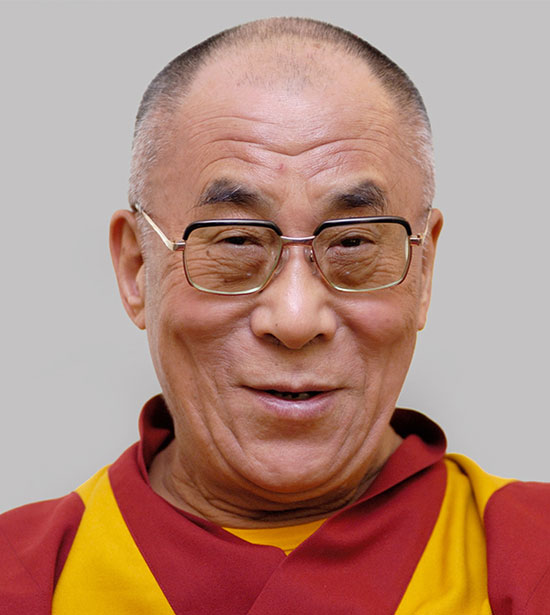
H. H. The 14th Dalai Lama, Tenzin Gyatso.
His Holiness The 14th Dalai Lama, Tenzin Gyatso.
Of all prominent living people, I am most inspired by H.H. the Dalai Lama – the spiritual leader (and former political leader) of Tibet. Apart from his Holiness’s spiritual attainments, which are beyond my comprehension, I am especially inspired by his universal compassion, wisdom, humility and humor.
I see him as a living exemplar of human potential – a Boddhisattva helping countless sentient beings and all life on our precious planet in infinite ways beyond religion or politics. Although my encounters with His Holiness have been impersonal – only as part of large audiences or via videos or writings – I feel a deep connection and harmony with him as a revered fellow human being.
Ever since an October, 1989 darshan, I have wondered whether that harmonious connection began in other lifetimes. At that time, I had the good fortune of being one of a limited number of people privileged to attend a ceremony to be conducted by His Holiness atop sacred Mount Tamalpais in Marin County, in a natural outdoor amphitheater. Because of limited highway access, the Dalai Lama was scheduled to arrive by helicopter. But his flight was delayed, and so we awaited his arrival.
Instead of waiting in the amphitheater, I decided to meditate in a nearby nature place. Then, on contemplating the Dalai Lama I experienced such heartfelt affinity and reverence, that I began an intense and protracted devotional crying jag. I became so overwhelmed with emotion of devotion that I was unable to stop weeping and enter the amphitheater even when I heard the sounds of the helicopter’s arrival. Ultimately, a compassionate Buddhist woman, who on her arrival had observed me crying, came out and taking me by the hand led me, still weeping, into the amphitheater.
The Dalai Lama is the only Tibetan teacher, including Kalu Rinpoche, with whom I have continuously felt such a deep devotional rapport – like my rapport with Guruji. He is regarded by Tibetans as the Bodhisattva of Compassion, and perhaps it is this subtle energy which opens my heart. In all events, though I don’t yet remember another life as a Tibetan, I intuit an important karmic connection with His Holiness, and regard him as a role model for living an ethical and compassionate life, regardless of our religious or cultural history.
Here are some of the ways in which I have been inspired by the Dalai Lama’s life and teachings:
Compassion. In his ever inspiring deportment, talks, and writings, His Holiness manifests and emphasizes the crucial importance of compassionate behavior – even with enemies. Drawing great inspiration from him, I have gradually come to regard everyone I meet – including those with whom I have disagreements – as spiritual siblings – brothers or sisters all sharing the same aspirations for happiness and peace of mind, despite superficial cultural differences. And, despite my pronounced lawyer’s tendencies to combatively judge all adversaries, more and more I have even found compassion for those whose ignorance of their true spiritual identity leads them to egregiously harmful behaviors. For example, at a time when I considered former US President George Bush, Jr., a war criminal and mass murderer, His Holiness publicly described him as “a nice man.” Hopefully, he privately influenced Bush – with whom he shares the same July 6th birthdate – to adopt more compassionate ethics.
Humility. His Holiness is regarded by Tibetans and by many others as a living Buddha. For, example, a Tibetan emigre attending a Tibetan Losar new year ceremony conducted in Minneapolis by His Holiness told a newspaper reporter there that “for Tibetans in exile, seeing the Dalai Lama is akin to Christians getting to meet Jesus”. Moreover, especially since his nomination for the Nobel Peace prize, His Holiness has become like a world-wide rockstar celebrity, attracting capacity audiences for all public appearances. Yet he remains exceptionally humble, describing himself as “a simple Buddhist monk” and member of the Human family. Despite his renown as a living sage, I have heard him several times answering questions with “I don’t know”. In my experience, this is very rare behavior for an elevated Eastern spiritual teacher. For example, I have never heard of any such humble response from elevated Hindu teachers regarded as avatars or ‘god-men’. I was especially drawn to Guruji who (despite his Hindu acculturation) was exceptionally humble, and even told my friend Joy Massa: “follow your heart, even if it contradicts my words”.
I have always felt ambivalent about spiritual teachers who pontificate as if they are infallible. For me, such behavior encourages adulation over inspiration. And I am uncomfortable with any spiritual group or tradition emphasizing adulation of the incarnate over adoration of the Infinite.
In my opinion, selfless humility is a supreme virtue. It is especially rare in prominent people who are subject to great flattery, praise and adulation, which can easily entice and inflate ego, the enemy of compassion and humility. Those like the Dalai Lama, Guruji, Gandhi and Einstein, who have resisted such ego temptations I consider inspiring great beings.
Universal morality and ethics beyond religion. In public talks and in his recently published book “Beyond Religion: Ethics for a Whole World” His Holiness explains how inner values “are the source of both an ethically harmonious world and the individual peace of mind, confidence and happiness we all seek”, concluding that “the time has come to find a way of thinking about spirituality and ethics that is beyond religion” which alone “is no longer adequate”. To me, this is a crucially inspiring message, which completely coincides with my philosophy and life experience. Before publication of “Beyond Religion” I established The Perennial Wisdom Foundation dedicated to elevating awareness of universal principles – like the ‘Golden Rule’ – at the heart of all enduring religious, spiritual, and ethical traditions. And His Holiness’s book and teachings have encouraged me to continue pursuing that path.
Politics, Economics and Ecology. Just as the Dalai Lama’s views on universal morality and ethics beyond religion have paralleled my views and inspired and encouraged me to pursue them, His Holiness supports liberal political, economic and ecological views with which I have long identified and pursued as a social justice advocate.
He recognizes as “a very great thing” Mahatma Gandhi’s sophisticated political implementation of ahimsa – the ancient moral teachings of nonviolence and non-injury. As an engaged Buddhist, the Dalai Lama outspokenly endorses Gandhian non-violent and compassionate political social action benefitting the majority of citizens, especially those underprivileged and exploited.
Thus, he rejects capitalist economics, as focussed on greed, gain and profits and outspokenly endorses democratic Marxist theory of equitable access to means of production and distribution of wealth. But, he rejects as lacking compassion and encouraging class hatred the so-called Marxism of the failed totalitarian former USSR, or China, and he objects to their excessive emphasis on class struggle.
Ecologically the Dalai Lama recognizes that Earth is severely threatened by ignorant human greed and lack of respect for all life on our precious planet. Accordingly, he urges that we become actively engaged as a global human family to resolve this crisis with compassionate solidarity, not just as a matter of morality or ethics but for survival of life as we know it. (See e.g. Spiritual People in a Perfectly Crazy World)
Conclusion. Thus I am supremely grateful for the wisdom and inspiration bestowed by Tibetan teachings and teachers, especially through His Holiness The 14th Dalai Lama, Tenzin Gyatso, who for me is a living exemplar of human potential – a Boddhisattva helping countless sentient beings and all life on our precious planet in infinite ways beyond religion or politics.
Choosing Happiness: No Arms No Legs No Worries
“The greatest discovery of any generation
is that human beings can alter their lives
by altering the attitudes of their minds.”
~ Albert Schweitzer
“Though we may not be free to choose our outer circumstances in life,
we are always free to choose our attitude and thoughts about those circumstances.”
~ Ron Rattner, Sutra Sayings
It’s not our longitude
Or our latitude,
But the elevation of our attitude,
That brings beatitude.
***
So an attitude of gratitude
Brings beatitude.
~ Ron Rattner, Sutra Sayings
“Gratitude is not only the greatest of virtues,
but the parent of all others.”
~ Cicero

Nick Vujicic is an inspiring Australian motivational speaker and Christian evangelist who was born without arms or legs. As a child, he struggled mentally and emotionally as well as physically. But eventually, with perseverance and faith in God, Nick discovered that his state of mind determined his happiness, and that we choose our state of mind.
Thereby he learned to gratefully accept his life just as it is.
He teaches his crucial insights not only with his words but mostly by his life example. Though he can’t walk physically, he metaphorically walks his talk.
Here is a powerfully inspiring four minute video in which Nick both articulates and demonstrates his fundamental teaching – that an attitude of accepting our life with faith and gratitude brings happiness.
https://www.youtube.com/watch?v=SjbX6mDnMwM
Nick Vujicik ~ No Arms No Legs No Worries
From Mata Amritanandamayi to Amma Shri Karunamayi ~ Ron’s Memoirs
“… if someone is supposed to propagate the Dharma and their behavior is harmful, it is our responsibility to criticize this with a good motivation. This is constructive criticism, and you do not need to feel uncomfortable doing it. In “The Twenty Verses on the Bodhisattvas’ Vows,” it says that there is no fault in whatever action you engage in with pure motivation. Buddhist teachers who abuse sex, power, money, alcohol, or drugs, and who, when faced with legitimate complaints from their own students, do not correct their behavior, should be criticized openly and by name. This may embarrass them and cause them to regret and stop their abusive behavior. Exposing the negative allows space for the positive side to increase. When publicizing such misconduct, it should be made clear that such teachers have disregarded the Buddha’s advice. However, when making public the ethical misconduct of a Buddhist teacher, it is only fair to mention their good qualities as well.”
~ Dalai Lama, Ethics in the Teacher-Student Relationship, 1993
“Can a guru who displays jealousy and competition toward other spiritual leaders help seekers? Such behavior shows that the personality aspects, each with its own ego, are still in control.”
~ Swami Sivananda Radha, “In The Company of The Wise”, page 190
“Do not believe in anything simply because you have heard it.
Do not believe in anything simply because it is spoken and rumored by many.
Do not believe in anything simply because it is found written in your religious books.
Do not believe in anything merely on the authority of your teachers and elders.
Do not believe in traditions because they have been handed down for many generations.
But after observation and analysis, when you find that anything agrees with reason and is conducive to the good and benefit of one and all,
then accept it and live up to it.”
~ Buddha

Shri Amma Karunamayi
Introduction.
After Guruji returned to India in 1980, I met and learned from many other teachers. Beginning in 1987, I was especially attracted to the devotional path of Amritanandamayi (Ammachi) of calling and crying to the Divine, and for seven years I attended many of her US darshans and regular programs at her San Ramon ashram. (See https://sillysutras.com/other-teachers-mata-amritanandamayi-ammachi-rons-memoirs/)
But while drawn to Ammachi’s devotional path, I continued meeting other spiritual teachers. Through my interest in Ammachi, I met Shri Vijayeshwari Devi another memorable Indian female teacher known as Amma Shri Karunamayi who like Ammachi is revered by some devotees as an avatar or embodiment of divine mother. I met Karunamayi under surprising circumstances which ended my relationship with Ammachi and sparked an important new transformative life phase of increasing reliance on inner rather than outer authority. (see e.g. my essay “I’ve Found A Faith-Based Life”)
Learning of Amma Shri Karunamayi.
In 1995, my trusted friend Richard Schiffman – a talented spiritual poet, author and mainstream journalist – who I had met at an Ammachi program in New Mexico after he had lived many years in India – told me by phone that Amma Shri Karunamayi a female Indian spiritual teacher considered a Divine Mother avatar had recently visited New York and other US areas for the first time. He said that many Ammachi New York devotees had been greatly impressed by Karunamayi, and that some wanted to help her organize future US tours. From Richard’s description of Karunamayi, I felt a strong desire to see her, so I asked Richard to keep me informed of her schedule.
Synchronistically, just after Richard told me about Karunamayi, I received two letters from friends in India, telling how they had just spent a month with Karunamayi in Bangalore. They said she is “quite special [and] incredibly gentle and soft and radiates a beautiful and loving presence”, and that “many miraculous stories [are] attributed to her”. They recounted some of those stories, and reported that because Karunamayi was college educated with a focus on meditation (and not hugging) she attracted some more sophisticated devotees than the devotionally adoring people often attracted to Ammachi.
In March 1996, I again received a synchronistic phone call concerning Karunamayi, this time from another spiritual friend, who – like Richard and my friends in India – was also an Ammachi follower. Until then I was unaware that she knew of Karunamayi. So I was quite surprised when my friend asked if I could suggest some Bay Area place where Karunamayi and her entourage could stay in a few months during their first Bay Area visit. Only then did my friend disclose that she had met Karunamayi in Seattle in 1995 where she had offered to host Karunamayi’s first Bay Area visit in 1996.
Also, my friend credibly explained that Ammachi’s New York devotees had received an ‘edict’ from Ammachi – which I later confirmed – against helping or seeing Karunamayi; that she had changed her mind about hosting Karunamayi based on “personal considerations”, and because she felt disharmony with Karunamayi’s national organizers who were aggressively putting undue time pressure on her.
With compassion for my friend’s dilemma, and motivated by a sense of injustice about Ammachi’s ‘edict’ against Karunamayi, I offered to make inquiries about possible San Francisco places where Karunamayi’s entourage could reside and give public programs. But, I explained that since I was living a reclusive life in a small apartment I could not offer to personally host Karunamayi’s large entourage.
Thereupon, my friend called the national organizers for Karunamayi, “resigned” as Bay Area sponsor, and gave them my phone number as a San Francisco contact who might look for appropriate venues. Without consulting me, the Karunamayi national organizers then “conscripted” my services by distributing national flyers with my phone number as their San Francisco organizer.
Despite my displeasure with that involuntary “conscription” as a Karunamayi organizer, I did not – like my friend – tell the national organizers to ‘take me out of the loop’. My sense of compassion and justice inhibited me from leaving Karunamayi without help in the Bay Area. So I decided to help Karunamayi while seeking others who would replace me as Bay Area organizer. Thereupon my daily regime of solitary meditation and prayer and walking in Nature was significantly changed as I made and received phone calls, wrote letters and inspected possible darshan halls.
Though I never located a replacement Karunamayi sponsor, I found several friends who agreed to help. A recently widowed friend who lived alone in a very large Presidio Heights residence agreed to house Karunamayi’s entourage, and to allow morning public gatherings there. Another friend agreed to answer all telephone inquiries about Karunamayi’s schedule. And my dear friend Bina Chaudhuri – widow of Dr. Haridas Chaudhuri, with whom she had co-founded the California Institute of Integral Studies (CIIS) and the Cultural Integration Fellowship (CIF) – arranged for Karunamayi’s evening programs to be held in the lovely CIF main hall.
Meeting Karunamayi.
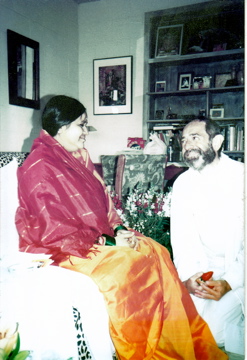
Ron with Karunamayi
As Karunamayi’s first San Francisco sponsor, I was privileged to have various private discussions with her. I learned that like Ammachi Shri Vijayeshwari Devi had no lineage or guru, but that her mother had been a devotee of Shri Ramana Maharshi, who was told by Ramana when pregnant that she would give birth to Devi [“the Mother”]. Just short of college graduation, Karunamayi had retreated to a remote forest where she spent ten years in solitary rigorous practice. Like Guruji, and consistent with her extraordinary early sadhana, Karunamayi’s emphasis was on meditation. Her presence evoked for me moods more meditative than devotional, and inspired my poetry about silence. (see e.g. https://sillysutras.com/in-silence-sweet/) Like Guruji she apparently perceived my subtle auric field. Most memorably she once told me that: “Dhyanyogi has greatly helped you in ways you can not yet know.”
She did not insist that devotees have only one guru.
Once as I was driving Karunamayi and Swami Vijashwarananda – her cousin and Telugu/English interpreter – to the beautiful Marin County Vedanta retreat center, the Swami asked: “Mother wants to know what you eat?” In response I told him: “I eat mainly raw fruits and vegetables, nuts and seeds, and rice and beans.” Whereupon the Swami interpreted my words for Karunamayi, who laughed and replied in Telugu. Then Swami said to me: ”Mother says you’ve eaten like that for many lifetimes.”
Unlike Ammachi, Karunamayi repeatedly encouraged devotees to seek company of other spiritual teachers, as well as to meditate regularly.
The “last straw” with Ammachi.

All my helper friends – like me – were Ammachi followers, but none of us felt conflict with Ammachi since Karunamayi’s San Francisco visit was scheduled for August when Ammachi would not be here. Though my sense of fairness was severely shaken by Ammachi’s New York ‘edict’ against Karunamayi, for a while I suppressed those feelings, along with my long suppressed concerns about a commercialized cult of personality around Ammachi, and the Mother Meera book burning incident. So at first that edict did not quite become “the last straw” in ending my faith in Ammachi.
That happened only after I learned of defamatory gossip and rumors about Karunamayi attributable to the Ammachi organization. Especially after I had met and was blessed by Karunamayi, and was experientially convinced of her authenticity as a spiritual master, I became deeply offended by these false and scandalous rumors, and motivated to help her as an ‘anti-defamation’ attorney.
For many years one of my daily Hindu practices from Guruji was recitation of the Hanuman Chalisa – a poetic ode to the legendary monkey-god Hanuman by poet-saint and philosopher Tulsidas. Though when I met Karunamayi my daily Chalisa practice had lapsed, Karunamayi saw the Hanuman Chalisa in my subtle field and, during a ceremony atop sacred Mount Tamalpais in Marin County, she spontaneously asked me to recite it as part of the ceremony.
Serendipitously, I had just received by mail from my friends in India a beautiful printed version of the Hanuman Chalisa. In a letter to them acknowledging that gift, I wrote:
“Slanderous rumors about Karunamayi originating at the ‘Kerala cuckoo compound’ have strongly activated my justice vasanas [propensities].” — so I wish to — “help as Her self-appointed anti-defamation lawyer. The Chalisa venerates Hanumanji as ‘the protector of saints and sages’, and after many years of recitations, I’ve assimilated some of that energy.”
So, despite my gratitude for the many devotional blessings I had received in Ammachi’s presence, after several years of growing but suppressed concerns about an ‘adulation of the incarnate’ rather than ‘adoration of the Infinite’ atmosphere around her, and about my diminished energy at her satsangs, my realization of Ammachi’s apparent jealousy and competition toward Karunamayi, Mother Meera and other teachers proved “the last straw” in my relationship with her.
Moreover, this realization traumatically brought to my consciousness the long-suppressed awareness that naively and mistakenly I had been projecting perfection onto Ammachi, rather than seeing her as a limited human being; that in adulating Ammachi I was misperceiving my own best qualities. This sudden ‘perfection projection realization’ triggered an important new transformative life phase of increasing reliance on inner rather than outer authority, which I will recount in other memoirs chapters.
(*see footnote)
Epilogue.
For many years I have been reluctant to publicly share my disaffection with Ammachi and her organization. I did not wish to discourage other devotees with different perspectives, some of whom are friends. But I now feel morally impelled to share my observations which support credibility of a recently published critical book about Ammachi, by Gail Tredwell (aka “Gayatri” or “Swamini Amritaprana”), who for twenty years was Ammachi’s revered personal attendant, and first and closest Western female devotee. Her memoir entitled “Holy Hell, A Memoir of Faith, Devotion and Pure Madness” contains many shocking but credible revelations, including reference to Ammachi’s ‘edict’ against Karunamayi (at pages 264-266).
Unable truthfully to attack the credibility of Gail’s memoir about Ammachi, the MA Centers organization has attacked Gail’s character by asserting that she is “a troubled individual” whose writings are “completely untrue and without a basis in fact or reality”, and by instigating and publishing false and defamatory rumors and on-line blog posts about her, while asserting meritless libel claims to intimidate others against commenting on or republishing Gail’s sincere perspectives.
Since I am quite convinced that Gail’s memoirs are true and sincere, I find deeply disrespectful and offensive such an ad hominem attack on her by those to whom she selflessly dedicated much of her adult life. Just as I felt impelled to assist Karunamayi against defamatory rumors, I now feel dharmically impelled to support Gail’s credibility.
Footnote.
* In further memoirs I will tell how – like some other Westerners without any guru tradition – I was naive about Ammachi and other limited or flawed Eastern teachers onto whom I mistakenly projected purported perfection and infallibility, rather than seeing them as limited humans though perhaps further evolved in spiritual awareness. And, I will recount how while faithfully revering my beloved Guruji, and while remaining grateful for blessings received from all my spiritual teachers – including Ammachi – I more and more began relying on inner rather than outer authority; and how whimsically I told friends that I had been transformed from “Born-again Hindu” to “Uncertain Undo”; from Gurubhai to ‘Guru bye bye’.
To karmically repay those few teachers I’ve forsaken in this life, in my next incarnation I may become an insurance underwriter/salesman specializing in custom coverage for spiritual teachers called: “Perfection projection protection”.
Transmuting Agony to Ecstasy: An Unforgettable Indian Commuter Train Ride ~ Ron’s Memoirs
“The hurt that we embrace becomes joy.”
~ Rumi
“Suffering, cheerfully endured, ceases to be suffering and is transmuted into an ineffable joy.”
~ Mahatma Gandhi
“Acceptance of the unacceptable is the greatest source of grace in this world.”
~ Eckhart Tolle
“Surrender, one could say, is the inner transition from resistance to acceptance, from “no” to “yes.” When you surrender, your sense of self shifts from being identified with a reaction or mental judgment to being the space around the reaction or judgment. It is a shift from identification with form–the thought or the emotion–to being and recognizing yourself as that which has no form–spacious awareness.”
~ Eckhart Tolle
“This is the miracle. Behind every condition, person or situation that appears bad or evil, lies concealed a deeper good. That deeper good reveals itself to you, both within and without through inner acceptance of what is. “Resist not evil” is one of the highest truths of humanity.”
~ Eckhart Tolle
We have nothing to surrender
But the idea
That we’re someone,
With something
To surrender.
~ Ron Rattner, Sutra Sayings

Introduction
In January, 1992, just after my retirement as a San Francisco litigation attorney, I journeyed to India to pay respects to my then one hundred fourteen year old beloved Guruji, Shri Dhyanyogi Madhusudandas, and thereafter to visit my daughter Jessica who – known as “Yogini” – was living an ascetic life on Ammachi’s ashram in Kerala.
During my six week stay in India, I was blessed with many wonderful spiritual experiences with Guruji, and with other holy people and places. But, apart from my brief visit with Guruji, [See https://sillysutras.com/introduction-to-rons-memoirs/] my most memorable and instructive spiritual experience happened unexpectedly on a commuter train to Bombay (now Mumbai).
By that time – sixteen years after my mid-life spiritual awakening – I had already learned from my traumatic divorce that life’s most painful and difficult experiences can prove disguised blessings. Suffering extreme sadness from unexpectedly being separated from my two young children – the most psychologically traumatic time of my adult life – had triggered my spiritual awakening process. A broken heart had opened my heart to new ‘realities’ and sparked a crucial new evolutionary period of spiritual self awareness and self inquiry – a tremendous blessing!
And prior to 1992 I had learned experientially and from many spiritual teachings the importance of spiritual surrender – of giving up imagined control and of letting go to go “with the flow”. For example, during a presumed 1979 ‘near death’ experience, when I mistakenly thought I was dying from a stroke, by watching within without resistance to presumed imminent death, I had an unforgettable inner experience. [ See https://sillysutras.com/my-near-death-experience/ ] But it is much easier to say “go with the flow” or “let go and let God” or “leave it to The Lone Arranger” than to practice that wise advice – especially when you are suffering. Except for very rare beings, like Guruji, we are all in the process of ‘undoing’ and letting go of who we think we are, to thereby realize what we really are – Divinity incarnate.
My Bombay commuter train experience proved an important demonstration of how accepting “what is” can bring great blessings, and how the blessings of letting go of ego, can be triggered by extreme pain and suffering.
Description
Here is what happened:
At the end of January 1992, I flew from San Francisco to Bombay, India [ now Mumbai] with my friends Pundit Pravin Jani, father of Shri Anandi Ma, Guruji’s successor, and Kusuma, Guruji’s former cook and translator. We were also honored to be accompanied by Shri Swami Shivom Tirth, a respected Indian shaktipat guru who, as successor to Swami Vishnu Tirth, headed India’s largest shaktipat lineage with several ashrams. We had known and learned from Swami Tirth for a few years before our trip to India and greatly honored and respected him.
With Pravinji and Kusuma as companions, I planned on visiting Guruji, who was then in Ahmedabad, the largest city in Gujarat State. However, our visit was delayed until after my Indian friends first attended to other personal matters.
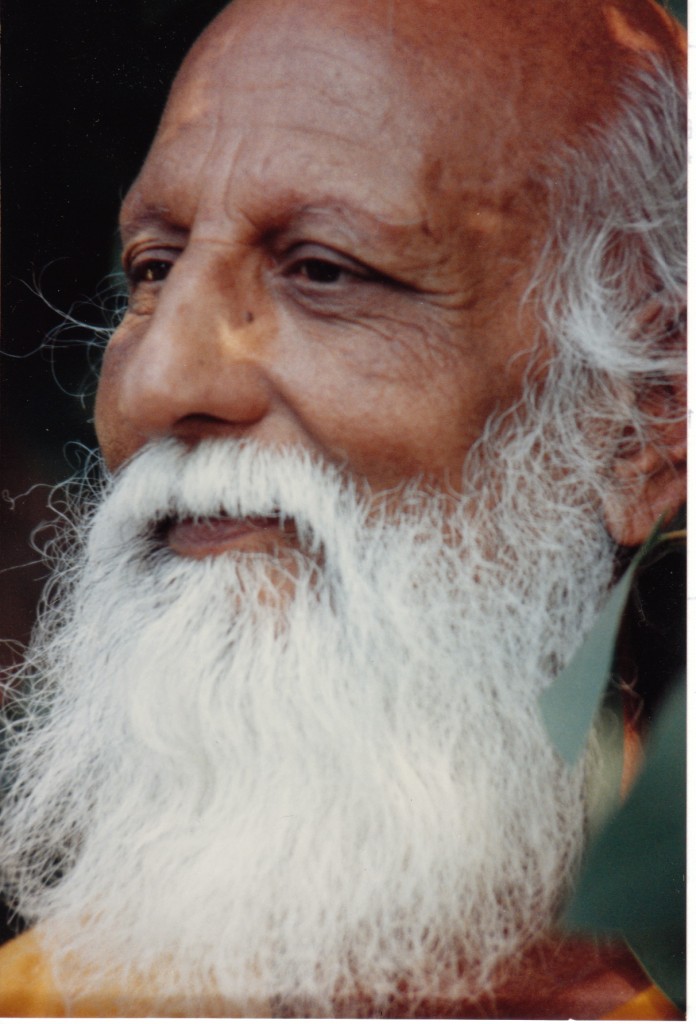
Shri Swami Shivom Tirth
So Swami Shivom Tirth invited me to stay with him at his Bombay area ashram, until I was ready to fly to Ahmedabad. Gratefully, I accepted his kind invitation and was granted the honor and privilege of staying with him in his private quarters, rather than in the general ashram housing area.
Soon after my arrival at the ashram, Swami Tirth told me that he had arranged a special sight-seeing excursion for me to view legendary seventh century Hindu and Buddhist temples in rock-cut caves on Elephanta Island in the Bay of Bombay; that a senior Bombay area swami was to be my guide and companion on the excursion; that I was to meet him – in a few days – in central Bombay, where we would get ferry boat transportation to the island.
At the ashram it was very hot, so I wore light white clothes and sandals, instead of shoes. Before my scheduled tour day I suffered a wound on my left foot, which became infected. Despite first aid, the infection grew and became increasingly more painful. On the day of my scheduled tour I awakened with a very sore left foot. Nonetheless I was determined to see the Elephanta Island caves and relics.
So I walked to a nearby train stop, to catch a morning commuter train into central Bombay where I would meet my Swami tour guide. Instead of wearing sandals which were inappropriate for hiking on the rocky island paths, I was obliged to use shoes. It was a very hot day, with morning temperatures already approaching 100º fahrenheit.
My feet expanded as I walked to the train stop in the heat, and the already painfully infected left foot began aching more than ever before as I reached the train stop. Within fifteen minutes, the Bombay commuter train arrived, and stopped for boarding passengers. But there were no seats, and not even standing room in the vestibule. Yet in order to get to central Bombay on time, I needed to board that train for a forty minute ride.
Somehow I squeezed into the vestibule, which was already so filled with people that there wasn’t even an accessible pole or strap to hold for balance. People were packed in like sardines, and I was virtually unable to move. I stood there in the intense heat with excruciating pain that seemed to have become unbearable. But I could do nothing about it. Whereupon, suddenly and unexpectedly I had a radical change of attitude; I stopped resisting and stopped thinking how terribly I was suffering, and mentally accepted the situation just as it was.
With a surrendered and stilled ego/mind no longer resisting the intense heat, crushing proximity of sweaty human bodies, and excruciating pain, all at once I experienced an extraordinary and unforgettably indescribable state of extreme bliss which persisted for the remaining thirty minute train ride into central Bombay.
Even after that bliss state abated in Bombay, I was able to peacefully enjoy my tour to Elephanta Island because I was no longer resisting the pain in my foot.
Epilogue
The Bombay commuter train experience of transmuting agony to ecstasy has proven an invaluable lesson for this entire precious lifetime. It showed that by giving up and surrendering all we think we are we may gain deep experience and insight of what we really are; that it is in dying to ego life that we are reborn to eternal life; and, that such letting go of ego entity identity is perhaps our ultimate purpose in this precious human lifetime.
A Long But Short Guruji Satsang Story
~ Ron’s Memoirs
“Silence is the language of God,
all else is poor translation.”
~ Rumi
“We search for Him here and there,
while looking right at Him
Sitting by his side, we ask:
Oh Beloved, where is the Beloved?
Enough with such questions
Let silence take you to the core of life
All your talk is worthless
when compared with one whisper of the beloved”
~ Rumi
As explained in other memoirs chapters, during a traumatic 1976 divorce I experienced a transformative mid-life spiritual awakening. Two years later, I met a one hundred year old Hindu guru, Shri Dhyanyogi Madhusudandas, and evolved from being a secular Hebrew, to becoming a “born-again Hindu”. And thereupon I developed an ever increasing interest and curiosity about Indian spirituality and culture. After a few years, the “universe” presented me with an ideal opportunity to satisfy that curiosity.
In 1981, soon after my beloved Guruji, Dhyanyogi, had returned to India, I met Sant Keshadavadas, a devotional Indian spiritual teacher known as a singing saint. Thereafter, on learning that Sant Keshadavadas would be conducting a spiritual tour of Indian holy places, I wanted to join that tour, if it was okey with Guruji.
Guruji had always told us that it was not necessary to see other spiritual teachers, but permissible. So I succeeded in getting his approval for me to tour with Sant Keshadavadas.
Thereupon, in January and February 1982, I journeyed with Sant Keshadavadas on a wonderful spiritual pilgrimage to Japan and India. That guided tour was, and remains for me, the most important trip of my lifetime. Never before had I been in a land with such a palpably spiritual ambiance as I experienced everywhere in India.
Our tour group crossed the length and breadth of that vast country (mostly by airplane and local buses) visiting many spiritual shrines and meeting saintly beings, like Mother Teresa, Anandamayi Ma and Satya Sai Baba. And I had numerous wondrous experiences. (In other chapters I will recount some of those experiences.)
Throughout the tour I was constantly seeking to learn how I could best advance my quest for “enlightenment” – my spiritual “sadhana”. By the time that the guided tour ended in New Delhi, I was quite weary from following the intense tour schedule. But I was determined to remain in India to pay my respects to my beloved Guruji, and to receive his guidance and blessing for my “sadhana”.
With unexpected difficulty, I finally succeeded in having only one brief ‘satsang’ with Guruji. This proved much more complicated – and much more memorable – than I could have previously imagined. (Satsang is a sanskrit word meaning being with a Sat Guru or being with “highest Truth” – https://endless-satsang.com/nondual-advaita-satsang.htm)
Here is the story of what happened.
After four years of tireless efforts in the US, Guruji had become extremely debilitated and was obliged to return to India in 1980 to recuperate. After his arrival in India, his whereabouts were sometimes kept confidential so he could rest and recover without constant interruption.
Before I departed for India in January 1982, I was told that after my guided tour ended I would be able to learn Guruji’s whereabouts by calling Shri Anandi Ma’s father, Pundit Pravin Jani. And I was given his Bombay phone number.
Over a month later, just before our guided tour ended in New Delhi, I began trying to phone Pravin Jani – who was in Bombay – from my New Delhi hotel. In those days India had not yet joined the digital communication age, and surprisingly I could never get a long-distance telephone connection from Delhi to Bombay.
After repeated unsuccessful attempts, I decided to make a brief trip to Katmandu, Nepal to see Buddhist and Hindu holy places there. But, I remained determined to see Guruji. So on return to Delhi from Nepal, I again repeatedly tried calling Bombay to learn his whereabouts.
But I was still never able to get a long-distance telephone line from New Delhi to Bombay. So I had to book a flight across all of India from Delhi to Bombay, so that I could then make a local Bombay phone call to Pravin Jani. Only by so flying to Bombay was I finally able to reach him by telephone.
Whereupon he readily told me that Guruji was then staying in Godhra a small town not far from Ahmedabad, the largest city in Gujurat state. Paradoxically, my flight from Delhi to Bombay had overflown Ahmedabad long before it reached Bombay. If I had known Guruji’s whereabouts while in Delhi I would have flown directly to Ahmedabad. But that hadn’t happened.
So, it was now necessary for me to book a flight from Bombay to Ahmedabad, and to arrange ground transportation from there to Godhra.
But I then learned that the only flights to Ahmedabad had been cancelled, and that I could only get to Godhra by train. So, I needed to take an eight hour trainride from Bombay to Godhra, and learned of a departure later that day.
Thereupon, I promptly took a taxi to the Bombay central railroad station where I arrived less than an hour before the train was scheduled to leave. At the station ticket booth, I was told that no first class train compartment was available; that only non air-conditioned second class space was available for the long trip. With no other choice, I attempted to purchase a second class ticket using my American Express dollar travelers checks or credit card, which until then had been accepted everywhere I traveled in India. But they were both rejected by the train station cashier, who told me that they only accepted rupees, which I could get at a nearby American Express office in downtown Bombay.
Hurriedly, I left the train station and on the sidewalk asked the first knowledgable looking person I encountered if he could direct me to the nearby American Express office. Instead of telling me he couldn’t help me, he pleasantly and unequivocally told me where to go. I quickly followed his directions, which turned out to be completely wrong.
Frantically, I finally got proper directions which I speedily followed. Arriving at the American Express office soon after it had opened, I obtained necessary rupees from a very lackadaisical clerk and rushed back to the central station, arriving just as my train was scheduled to depart.
At the last minute I purchased a ticket and boarded the train just before its departure. Up to then my body – already quite weary from over a month of intense travel and last minute stress in getting directions to Guruji – had been running on extra adrenaline. But on boarding the train I soon realized that I needed to rest. However, that proved difficult.
The seating was not very comfortable, my compartment companions were not quiet, the sultry temperatures required that we keep windows open to outside disturbances, including noises from many interim station stops. So my first long journey on an Indian train proved very interesting, but not restful.
On disembarking at Godhra that evening I was quite travel weary but excited at the prospect of seeing Guruji again for the first time since he left my San Francisco apartment in 1980. I called the Godhra phone number given me by Pravin Jani and was courteously welcomed by one of Guruji’s hosts, a woman lawyer. I learned that Guruji was convalescing at the home of her father, a retired judge, and that I could see him for a short while at an appointed time the next morning.
That night I stayed at a Godhra guest house in a very warm room with a mosquito netted bed. Because of heat and bugs, I did not sleep soundly. But nonetheless I awakened with great excitement about my imminent satsang* with Guruji.
A few hours later I arrived at the judge’s house where Guruji was staying. There I was pleasantly greeted and told that Guruji was then in the garden, but that he would soon come in to greet me. I was brought into a lovely room with an altar and fresh cut flowers and an empty prominent throne-like seat for Guruji.
As I waited there, my ‘monkey mind’ became quite active. Despite all of my wondrous experiences during the pilgrimage tour, I was busily dialoguing with “the voice in my head” about questions for Guruji. So when Guruji came into the altar room and sat down in front of me, I was feeling far from peaceful. But I sat there quietly gazing at him, waiting for him to entertain my questions.
Though Guruji looked physically healthier than when he had been carried out of my apartment to return to India, he still looked quite fragile and much weaker than when I first met him four years earlier. But he was emanating indescribably intense ‘shakti’ life-force energy, which seemed as strong as ever. His aura was so extraordinarily powerful that it soon transformed my previously agitated state of mind. As I sat there I began harmoniously resonating with Guruji’s supernal ‘shakti’ life-force and felt more and more peace of mind.
And so “the voice in my head” stopped ‘talking’ and my previous questions for Guruji gradually seemed to melt into silent infinite awareness. But they didn’t all dissolve. So after sitting there in silence for a while, I asked Guruji a preliminary question. But he kept gazing at me without answering the question, and remained silent. Whereupon, supposing that he might not have understood me, I asked Guruji another question. But he still remained silent.
Finally, in desperation I exclaimed:
“Guruji, I’ve come halfway around the world to see you.
Please tell me what I should do for my sadhana.”
After a pregnant pause, Guruji at long last replied:
“Meditate regularly!”
We had no further dialogue. And soon I was politely informed by Guruji’s host that it was time to leave.
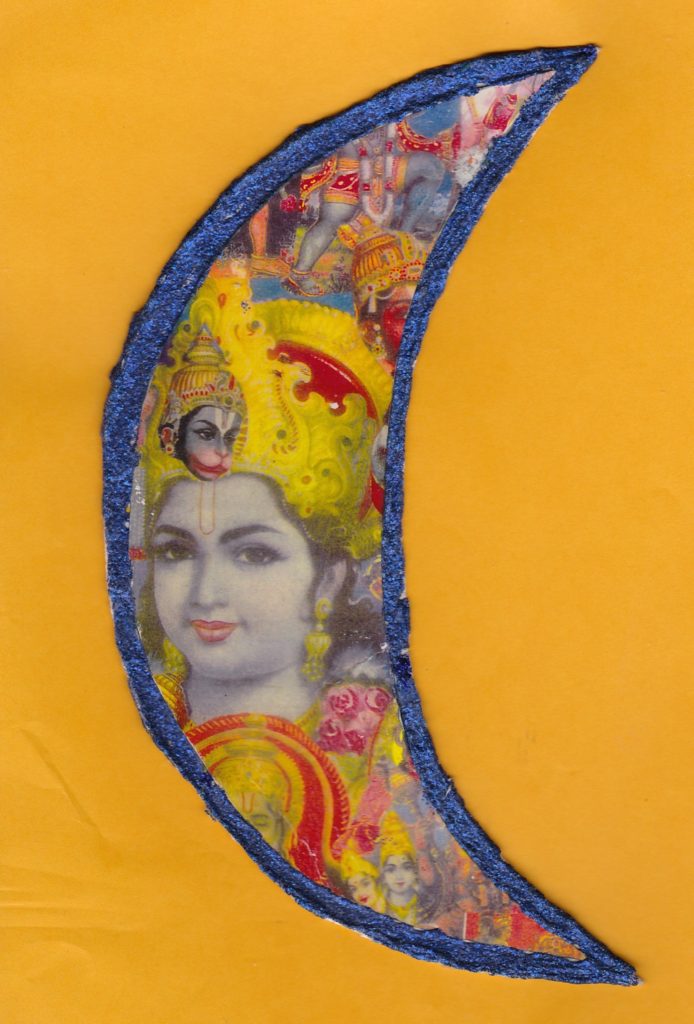
Epilogue
As you might imagine, the unforgettable memory of Guruji’s profoundly silent ‘satsang’ has remained indelibly imprinted in my heart and on my ‘mental software’. His words “Meditate regularly!” were not merely spiritual instructions, but a timeless heartfelt blessing or sankalpa that my deepest aspirations for Truth might be fulfilled through regular meditation!
Moreover, beyond words but only with deep mental silence, Guruji eloquently demonstrated that the eternal LOVE we all seek is within each of us; and he ineffably validated Rumi’s profound observation that
“Silence is the language of God,
all else is poor translation.”
~ Rumi
Since 1982 by faithfully following my beloved Guruji’s emphatic instructions and blessing for me to “meditate regularly” I’ve been learning about living with a stilled mind.
In 1996 (after Guruji’s 1994 mahasamadhi and during an extended post-retirement period of reclusion), I was inspired to compose this poem “In Silence Sweet”, which only hints at Guruji’s profound blessing bestowed in that unforgettable silent ‘satsang’.
In Silence Sweet
In silence sweet
we may retreat
from every care and woe,
and there we’ll learn in perfect peace
all we need to know.
In silence sweet
we shall meet
the thrill of ecstasy.
and thus we’ll learn in perfect peace
we’ve nothing more to be.
In silence sweet
we shall find
all we’ve ever sought.
And thus we’ll learn in perfect peace
that all our wants were naught.
In silence sweet
we shall see
that everything is light.
And thus we’ll learn in perfect peace
there’s naught to fear but fright.
In silence sweet
we shall greet
our own true Self and Soul.
And thus we’ll learn in perfect peace
we are the timeless Whole.
In silence sweet
we shall enjoy
Eternity’s repose.
For perfect peace we e’er shall be,
Peace no mortal knows.
Human Fallibility and Divine “Perfection” ~ Ron’s Memoirs
“Follow your heart, even if it contradicts my words”
~ Sri Dhyanyogi Madhusudandas
“Do not believe in anything simply because you have heard it. Do not believe in anything simply because it is spoken and rumored by many. Do not believe in anything simply because it is found written in your religious books. Do not believe in anything merely on the authority of your teachers and elders. Do not believe in traditions because they have been handed down for many generations.
But after observation and analysis, when you find that anything agrees with reason and is conducive to the good and benefit of one and all, then accept it and live up to it.”
~ Buddha
“All is Perfection,
but nobody’s perfect.”
~ Ron Rattner, Sutra Sayings
“Incarnation is limitation.”
~ Ron Rattner, Sutra Sayings
“All people are flawed;
None are perfect.
But the most flawed,
Are those who claim or think they’re perfect.”
~ Ron Rattner, Sutra Sayings
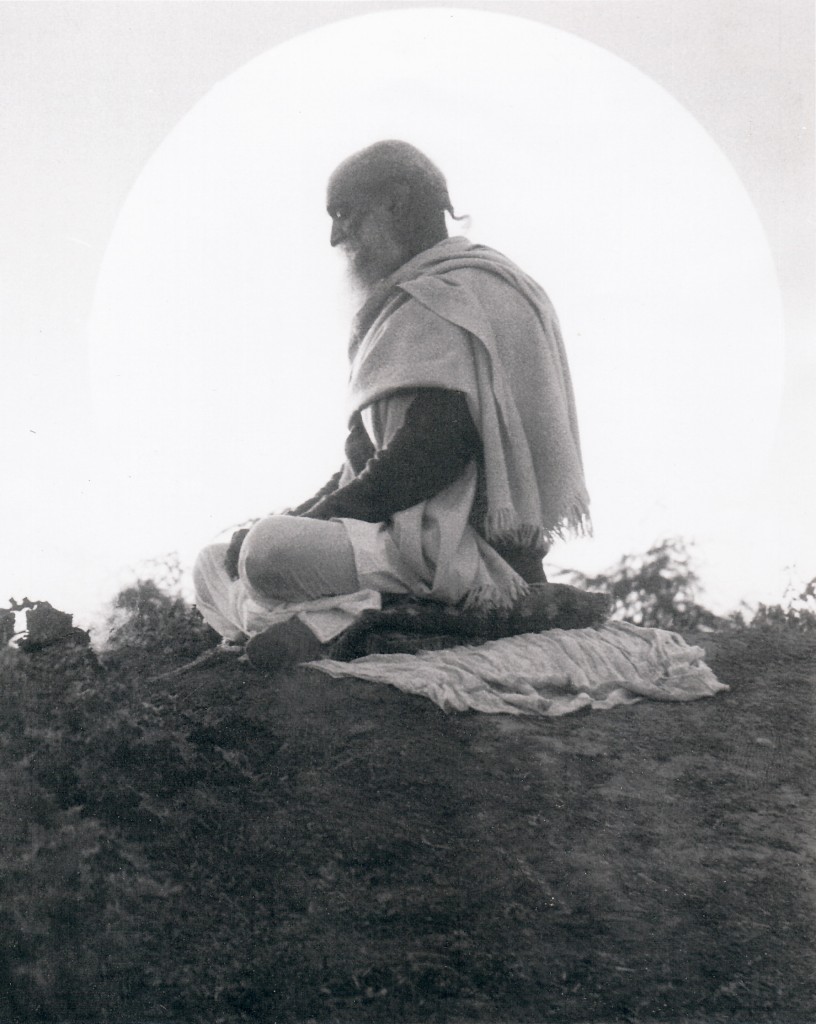
Shri Dhyanyogi Madhusudandas
Many of us have faith in an omnipresent and omniscient Divine Perfection which is beyond comprehension, imagination or description. And, knowingly or unknowingly, we seek such Perfection here on Earth. But in our phenomenal duality reality “perfection” is an idea, which implies it’s opposite – imperfection. We can’t have one, without the other. So, a “perfect” person isn’t possible.
[see, e.g. https://sillysutras.com/is-personal-perfection-possible/ ]
Some of us may be blessed to meet inspiring spiritual teachers, gurus or saintly people on whom we may project and, accordingly, in whom we may perceive perfection. I have done this with my beloved and venerable Hindu guru, Sri Dhyanyogi Madhusudandas, and with a few other “enlightened” spiritual teachers. But, ultimately, I have learned from inner and outer experience that incarnation is limitation, and that however evolved an incarnate being may be s/he is fallible. Here on Earth, where we experience life via physical bodies, it seems that human fallibility ‘goes with the territory’ – that “to err is human”.
Once while my friend Joy Massa was walking in the woods with our beloved Guruji, Dhyanyogi, he advised Joy:
“Follow your heart, even if it contradicts my words”.
This teaching was exceptionally noteworthy in view of the ancient Hindu tradition of complete surrender to the Guru. So I have reflected much about Guruji’s extraordinary message to Joy. And I have particularly wondered why Guruji did not directly give that profound teaching to most other disciples – including Ron.
I believe that when Guruji gave us personal teachings, they were appropriate to our particular state of evolution and to our unique karmic constraints. Thus, Guruji was especially encouraging Joy – an exceptionally intellectual person – to honor her ‘inner’ Guru’ over her intellect or outer authorities. Joy already was quite skeptical of outer religious authority and e.g. had rejected certain Catholic Church dogma, such as Papal infallibility.
Moreover, it appears that despite Guruji’s highly elevated state of evolution and extraordinary powers, he was acknowledging to Joy – with rare saintly humility – even his own earthly limitations.
In my experience, while living in this ever changing world, we need to rely vigilantly both on our powers of discrimination and on our divine intuitive insights. But, that whenever in doubt, it is wise for us to to honor intuition over intellect, and to find guidance in our heart – not our head; and, that we must still our mind so as to hear our heart, instead of listening to the ‘voice in our head’. Accessing our inner wisdom helps transcend many earthly limitations and to solve problems created by lower levels of human consciousness.
Here is an apt and insightful essay by spiritual author and teacher Andreas Mamet, entitled “The Braid”. *[see footnote]
The Braid
by Andreas Mamet
Our quest for spiritual empowerment has at its core the association with those who we believe can assist us in our endeavors by virtue of their accomplishments. For this reason, we seek out teachers and gurus.
When we imagine how an accomplished teacher might look like or behave, we draw many inferences from our Judeo-Christian belief system, which describes God as perfect and infallible. We conclude that a person who experiences nearness to God, or even full God-Realization, is infallible. We believe that such a person is perfect in making decisions and can do no wrong. This is what I believed three decades ago, at the beginning of my spiritual journey. Now, almost 30 years later, after much observation, I have come to think otherwise. Mistakes do not stop after an individual becomes God-Realized or finds her/himself emanating more and more Divine Light. Errors of judgment remain a possibility. This was one of the more surprising realizations for me, as I believed in the myth of infallibility.
This myth is promoted often by the priest archetype, the “god professional,” in as much the following illusion is projected: God is infallible. I am close to God. Thus, I am infallible, and you need to do exactly as I say. This defines very much the traditional guru-disciple relationship of olden days, reaching into our present. It is, however, to be noted that recent decades have shown many instances wherein gurus have imploded their structures by making decisions that, in the end, displayed poor judgment and created havoc. This left their disciples spinning, forced to wonder what happened here and come to their own conclusions or responses.
One response was that the guru or teacher is so enlightened that he merely gave this experience to us as lesson to learn. That is the “denial response,” seeking to uphold the illusion of the infallible master, justifying the continuing, uncritical association of the individual with the guru arechetype. The stance of total devotion and surrender is maintained.
There is a story that deals with the theme of total surrender as is often asked of the disciple archetype. Gurdjieff, a spiritual teacher at the beginning of the twentieth century, was on a trip by car. At one point the lights stopped working, and Gurdijieff asked his disciple to sit on the hood of the car and hold a flashlight. The disciple was about to climb up to do as asked when Gurdjieff stopped him, asking, “Does it not occur to you that this is a completely idiotic request?”
Yes, there are beings who are very close to the Divine. They emanate qualities that are breathtaking. When you come into their company, powerful experiences take place instantly. It is those experiences that lead us to assume the teacher is perfect, a satguru. This assumption is an illusion. Yes, enlightenrnent may be there. But infallibility is not.
This puts the entire concept of unconditional surrender out of commission. It places upon us the need for total responsibility and minute-to-minute alertness. We are to wake up from the sleep that lets somebody else tell us what to do and how to act. Every second, we are required to display intelligent wisdom, discernment, and accept or reject what is placed before us on the grounds of this discernment. Had the Gurdjieff disciple displayed this (hard-to-attain) ability, he would have told Gurdjieff, “No.”
But, to reject the action of a being we feel is God-Realized or God-Near is a most difficult thing. We are prepared to sacrifice our common sense and intelligent discernment for an act of idiocy if we believe that God is merely testing us. To reject a Buddha is most difficult. “When you meet the Buddha on the road, kill him!” The Buddha himself said that. What does this mean? It means that after a thorough and deep relationship with an awakened being, the attachment is so huge, it becomes an obstacle in the disciple’s process of liberation.
This is the image that I have created for myself to understand what happens in the arising of God-Nearness: It is like a braid. You take one strand of hair and braid it with another strand of hair. The strands become completely intertwined, utterly close … one section, the human; the next, the Divine.
This, to me, represents the reality of things. Hence, the entire system of Asian teachers, Tibetan lamas, and others based on surrendering to a “high consciousness” are promoting an illusion. I feel we have entered an era wherein this illusion will be revealed. The fact of the remaining humanness of the one who experiences God-Nearness will become more evident, and the old, traditional system of unconditional surrender will be recognized as inappropriate. It will gradually disappear.
This creates a problem of different kind. It remains a fact that there are those who, on the grounds of superior and long-established practice, have indeed generated a God-Nearness that supersedes our own. This simply has to be admitted and acknowledged. Respect is due where respect is due. It should be expressed. When a transmission of light and wisdom is given, respect and gratitude are to be given in return.
But we should be able to turn on a dime. The second a teaching or request is expressed that is inappropriate or simply painfully outdated (women on the left, men on the right, old patriarchal illusions and power structures promoted), it should be challenged on the spot. In this way, old traditions that simultaneously carry blessings and ignorance are stimulated by infusions of needed reform. Teachers who carry blessings and unreflected garbage of olden days are given food for thought. If these infusions are not accepted, considered to be sacrilegious gestures, then we should be willing to turn on our heels and walk.
In the end, the Divine Experience will come to us on the grounds of our longing for it. That is the basis. The longing for the Divine will fill our body with the experience of the Divine. Translate your longing into fervent, ceaseless practice. Call the Divine until the Divine is tired of hearing your voice and descends into your body completely to get rid of your crying.
* Andreas Mamet’s other writings can found on his blog and Facebook pages.
Ron’s Conclusion
Ultimate Truth is Mystery – unimaginable and intellectually inexpressible.
But, highest wisdom pointing us to that Mystery, is implicit in Shri Dhyanyogi’s precious teaching “Follow your heart, even if it contradicts my words”; it guides us to “Seek first the kingdom of heaven, which is within.” ~ Matthew 6:33; Luke 17:20-21
Heeding that wisdom, may each of us look within and ultimately be guided by our divine intuition – our sacred Heart, rather than by fallible ‘outer authorities’.
And so shall it be!
Laughter: Quotes and Hafiz poem
“When you realize how perfect everything is
you will tilt your head back and laugh at the sky.”
~ Buddha
“What is soap to the body, laughter is to the soul.”
~ Yiddish Proverb
“I would not exchange the laughter of my heart for the fortunes of the multitudes; nor would I be content with converting my tears, invited by my agonized self, into calm.
It is my fervent hope that my whole life on this earth will ever be tears and laughter.
Tears that purify my heart and reveal to me the secret of life and its mystery,
Laughter that brings me closer to my fellow men;
Tears with which I join the broken-hearted,
Laughter that symbolizes joy over my very existence.”
~ Kahlil Gibran
“Time spent laughing is time spent with the Gods.”
~ Japanese proverb
“Laughter is the shortest distance between two people.”
~ Victor Borg
“Sing because this is a food our starving world needs.
Laugh because that is the purest sound.”
~ Hafiz
“Blessed is he who makes his companions laugh.”
~ The Koran
“It is cheerful to God when you rejoice or laugh from the bottom of your heart.”
~ Martin Luther King Jr.
“I have been confronted with many difficulties throughout the course of my life, and my country is going through a critical period. But I laugh often, and my laughter is contagious. When people ask me how I find the strength to laugh now, I reply that I am a professional laugher.”
~ The Dalai Lama
Laughter ~ Hafiz
What is laughter? What is laughter?
It is God waking up! O it is God waking up!
It is the sun poking its sweet head out
From behind a cloud
You have been carrying too long,
Veiling your eyes and heart.
It is Light breaking ground for a great Structure
That is your Real body – called Truth.
It is happiness applauding itself and then taking flight
To embrace everyone and everything in this world.
Laughter is the polestar
Held in the sky by our Beloved,
Who eternally says,
“Yes, dear ones, come this way,
Come this way towards Me and Love!
Come with your tender mouths moving
And your beautiful tongues conducting songs
And with your movements – your magic movements
Of hands and feet and glands and cells – Dancing!
Know that to God’s Eye,
All movement is a Wondrous Language,
And Music – such exquisite, wild Music!”
O what is laughter, Hafiz?
What is this precious love and laughter
Budding in our hearts?
It is the glorious sound
Of a soul waking up!
Hafiz translation from: I Heard God Laughing – Renderings of Hafiz by Daniel Ladinsky
Kalu Rinpoche, the Zen Master and the Orange
“Reality is merely an illusion, albeit a very persistent one.”
~ Albert Einstein
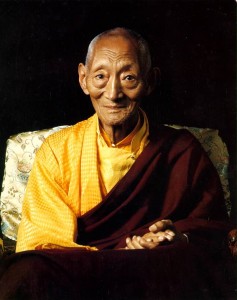
Kalu Rinpoche (1905 – May 10, 1989)
Ron’s Introductory Comments.
Is “reality” absolute or relative?
And how should the answer to that question influence our worldly ways?
Our phenomenal Universe is miraculous, marvelous, and meaningful. But it is ever changing and impermanent – a “relative reality” of space, time and causality which some mystics call illusion, samsara, or maya.
It arises and appears in an unchanging mysterious matrix of Infinite Potentiality, which some call “Absolute Reality”.
When aware or awakening to this distinction between Absolute and relative reality, we may realize that while we are apparent entities in this world, our Source and ultimate identity transcends this world; that we are ‘in this world but not of this world’.
Thus realizing the impermanence and relativity of our phenomenal reality, we may ponder on its meaning and purpose and, accordingly, on how to best behave herein: viz. what thoughts, words or deeds (if any) are most appropriate and skillful?
SillySutras.com is dedicated to raising perennial questions about how to best be in this world. Even spiritual masters and great scholars can disagree on answers to such questions.
So, ultimately, each of us must intuitively answer such questions for ourselves.
In the opening chapter of “Thoughts Without a Thinker”, concerning psychotherapy from a Buddhist perspective, author psychotherapist Mark Epstein recounts this apt anecdote about a meeting at the home of a Harvard University psychology professor of two prominent teachers of Buddha-dharma with different ideas about dharma.
“Thoughts Without a Thinker”, by Dr. Mark Epstein – Excerpt From Chapter One.
“In the early days of my interest in Buddhism and psychology, I was given a particularly vivid demonstation of how difficult it was going to be to forge an integration between the two. Some friends of mine had arranged for an encounter between two prominent visiting Buddhist teachers at the house of a Harvard University psychology professor. These were teachers from two distinctly different Buddhist traditions who had never met and whose traditions had in fact had very little contact over the past thousand years. Before the worlds of Buddhism and Western psychology could come together, the various strands of Buddhism would have to encounter one another. We were to witness the first such dialogue.
The teachers, seventy-year-old Kalu Rinpoche of Tibet, a veteran of years of solitary retreat, and the Zen master Seung Sahn, the first Korean Zen master to teach in the United States, were to test each other’s understanding of the Buddha’s teachings for the benefit of the onlooking Western students. This was to be a high form of what was being called ‘dharma’ combat (the clashing of great minds sharpened by years of study and meditation), and we were waiting with all the anticipation that such a historic encounter deserved. The two monks entered with swirling robes — maroon and yellow for the Tibetan, austere grey and black for the Korean — and were followed by retinues of younger monks and translators with shaven heads. They settled onto cushions in the familiar cross-legged positions, and the host made it clear that the younger Zen master was to begin. The Tibetan lama sat very still, fingering a wooden rosary (mala) with one hand while murmuring, “Om mani padme hum” continuously under his breath.
The Zen master, who was already gaining renown for his method of hurling questions at his students until they were forced to admit their ignorance and then bellowing, “Keep that don’t know mind!” at them, reached deep inside his robes and drew out an orange. “What is this?” he demanded of the lama. “What is this?” This was a typical opening question, and we could feel him ready to pounce on whatever response he was given.
The Tibetan sat quietly fingering his mala and made no move to respond.
“What is this?” the Zen master insisted, holding the orange up to the Tibetan’s nose.
Kalu Rinpoche bent very slowly to the Tibetan monk near to him who was serving as the translator, and they whispered back and forth for several minutes. Finally the translator addressed the room: “Rinpoche says, ‘What is the matter with him? Don’t they have oranges where he comes from?”
The dialog progressed no further.”

